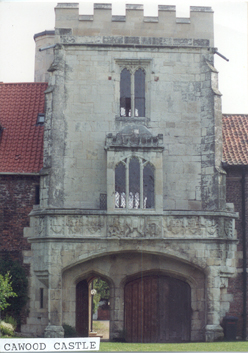The Gatehouse to Cawood Castle, Cawood, Yorkshire, England
Cawood Castle
The Gatehouse to Cawood Castle, Cawood, Yorkshire, England
The Cawoods came from Cawood, a village in Yorkshire, seven miles south of York. The most important feature in the hamlet was the grand manor house. King Aethelstan, the first Saxon king of all Britain, and the grandson of Alfred the Great, succeeded to the throne in 924 and erected the manor three years later. Historical accounts indicate that the house was in a finished state by the time Archbishop Walter de Gray (1216 – 1256) added to it. Archbishop Neville (1373 – 1388) also “laid out much on it.” In 1271 Archbishop Giffard acquired a license from King Henry III to furnish his manor house with battlements, thus converting it into a castle.
Visitations by British royalty increased the castle’s importance before and about this time, and it became known as the "Windsor of the North". King John visited it for fox hunting in 1210 and 1212. In 1255 King Henry III and his wife, Eleanor, stayed there en route to Scotland to visit their daughter, Margaret, who had married Alexander III. About 1299 King Edward I started for Scotland to subdue the Scots, who were attempting to free their country from English rule. Edward’s wife, Margurete of France, gave birth to a prince, Thomas de Brotherton, and she and her son resided at Cawood, with Edward visiting her frequently over the next five years. Edward also held some of his parliaments here. King Edward II stayed at the castle in 1314 after he was defeated in the Battle of Bannockburn. He and his queen stayed there in 1316 and again in 1322. And King Henry VIII stayed at Cawood Castle with Catherine Howard in 1540 when she was a bride.
15 January 1466
The Duke of Gloucester visited Cawood Castle for the occasion George
Nevill’s enthronement as Archbishop of York and the feast held the following
day. The feast is mentioned in the National
Geographic, Vol. 168, No. 5, November 1985, p. 674, although there are a few
discrepancies regarding the date and amount of some items. Two thousand cooks prepared
the menu:
300 quarters of wheat
300 tunne of ale
100 tunne of wyne
one pype of Ipocrasse
104 oxen
6 wylde bulles
1000 muttons
304 veales
304 porkes
400 swannes
2000 geese
1000 capons
104 peacocks
400 mallards and teales
204 cranes
204 kyddes
2000 chyekyns
4000 pigeons
4000 conyes
400 herpnshawes
2000 pygges
400 plovers
100 dozen quayles
200 dozen fowles called rees
4000 colde pasties of venison
1000 parted dishes of gelly
4000 cold baked tartes
3000 cold baked custards
2000 hot custards
100 curlewes
1000 egrittes
500 and more stagges, bucks and rees
608 pykes and breames
12 porpoises and seales
2000 hot custards
200 fessantes
4500 partridges
400 wodcockes
204 in bitters
spices, sugared delicates and wafers – plentie
Obviously, these people knew the meaning of the word, “party”. An enterprising young entrepreneur could have founded a family fortune by opening a “fat farm” nearby after an event like this.
Humpty Dumpty
At length the castle passed to Cardinal Wolsey, who let it fall into disrepair in the early part of his career (1514 – 1530), due to his residence at the Court, devotion to temporal affairs and his neglect of his diocesan duties. King Henry VIII sent Wolsey back home in 1523 after he failed to obtain a divorce from the Pope – a huge mistake on Wolsey’s part. Wolsey returned to the castle and began to restore it to its former grandeur. However, he was arrested for high treason in November, 1530 and ordered to London for trial. He left on 6 November, but took ill at Leicester and died in the Abbey there on 29 November. The story of his downfall is depicted in the children's nursery rhyme of Humpty Dumpty.
Wolsey’s successor, Edward Lee became Archbishop of York in 1531, and didn’t help the castle’s condition any by converting it into a prison. Sometime after this it was used as the headquarters of the Royal Commissioners “appointed to govern the north and put down Popery and rebellion.” Huh? The arrival of Mary Queen of Scots sparked off the Catholic rising in the north in 1569. The uprising failed and many were put to death. Oh, those Scots…
The House of Commons resolved on 30 April 1646 that several castles in the County of York, Cawood being one of them, be unoccupied, and no garrison kept or maintained in them. On 27 November of that year the Northern Committee of the Commons ordered at 2:00pm that Cawood Castle be reduced to a ruin. Some of the stone was then taken upriver to Bishopthorpe Palace, where it was used to extend the official residence of the Archbishops of York. The gatehouse and parts of the castle's foundation are all that remain. An excerpt from Who is This Fellow Cawood?, by Lawrence Cawood, 1962:
"The castle and palace are now partially in ruins, and there are fragmentary remains of foundations which seem to indicate a much greater area than presently appears. The great gateway is still intact. Over the west front of the arch runs a dado embellished with eleven shields of armorial bearings, over which is the principal window. Above the inner arch of the gateway is a beautiful mediaeval oriel window of four bays, each divided into four panels, and each of the four panels at the base contains a shield of arms. On the right of the gateway is a large brick building supposed to have originally been the chapel, lighted by six late Edwardian windows. It formerly contained an upper floor said to have been the banqueting hall of the archbishops. Only these fragmentary remains of Cawood Castle, mouldering relics of its former greatness, now exist, but the walled and moated enclosure can still be traced."
Lithograph of Cawood Castle in ruins

Gatehouse in 1995.
Updated 2-23-00.